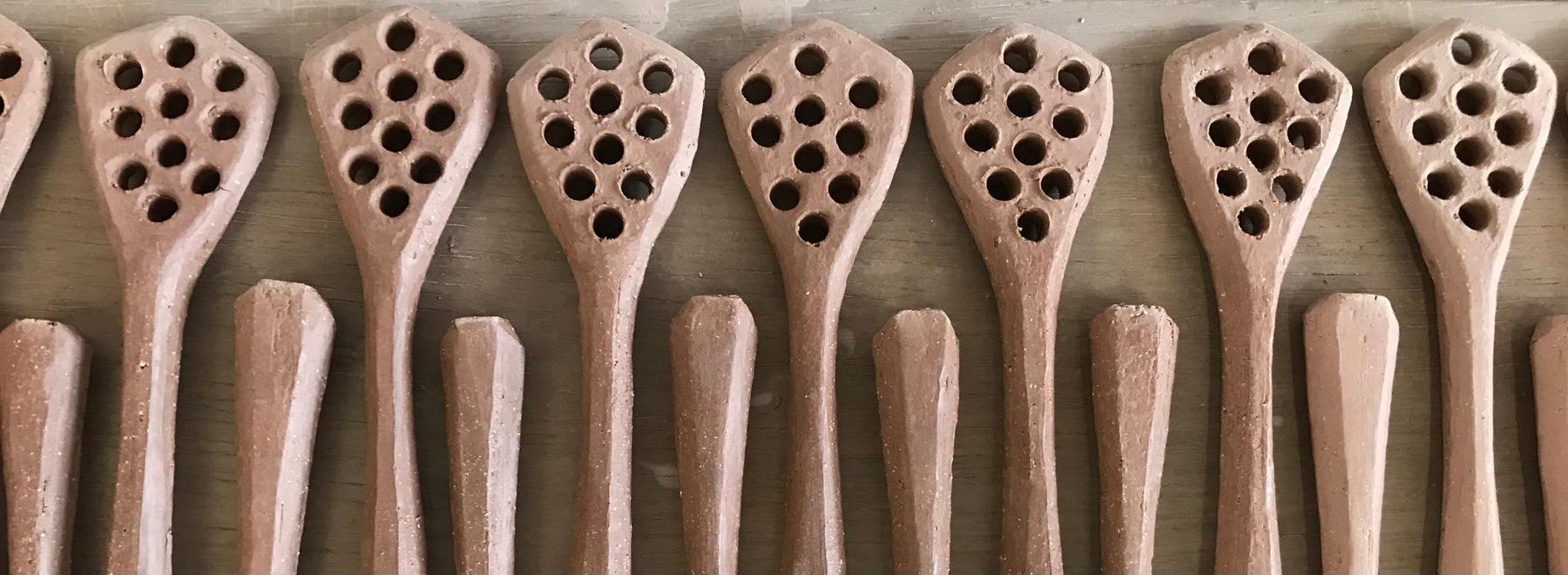
HANDMADE POTS FOR HANDMADE HONEY
We believe honey has a place on every table, which is why we reached out to St Ives ceramicist Kat Wheeler several years back with our vision for a ceramic honeypot. The idea was for a product true to our values of small-batch and handmade, which would provide a 'home' for a favourite jar of honey.
A place to store your sticky jar out of sight on the table, but also mean that it was always to hand for spontaneous sweet moments. We carried the idea around with us for a while, ever quite finding the right pair of hands to trust it to, until we visited Leach Pottery and met ceramicist Kat Wheeler.
Today, Kat works in the small community founded by a former Leach apprentice, known as the Gaol Yard Studios at St Ives. It's rather like our own Spa Terminus home as a collect of independent craftspeople sharing a common ethos. Kat not only literally works with the earth (her clay is particularly iron-rich and textured) but also draws her inspiration from her North Norfolk Coastal surroundings when it comes to her small batch, reduction fired stoneware. Her emphasis on organic form—features which appear to evolve organically from the clay, really spoke to us when we first saw her work. This was stoneware which felt like it belongs out there in nature, as a product of its environment. Her focus on taking something raw and allowing it to express itself without adulteration or intervention is of course, what makes what we do, ours too. What better partner for our raw British honey?


NEW IN: STONEWARE HONEYPOTS & SPOONS
Only the second commission she has made for us in five years, this is a super rare and limited chance to get your paws on one of Kat's one-of-a-kind designs, plus one of her charming new honey spoons.
There is a reason why you never see spoons made in ceramic - and we really had to convince Kat on this - because the process is so labour-intensive.
Together, honeypot and spoon are perfect for that time of year when honey could do with an extra layer of warmth. Each pot is made to perfectly house our 250g glass jar, and is available in quite unique slip patterns, so we suggest that means, one for you, one for a friend. We caught up with Kat briefly to chat about her craft process, and the particular challenge of this commission.
How would you describe your practice?
I do a lot of surface decoration, called slip decoration, which means decorating with a kind of watered down, white clay. I apply it with a really rough brush that's made from rice straw, which gives the surface its feathery, textural look. Because the clay that I throw is very dark and has a lot of iron in it, that white surface decoration creates a nice contrast.
What was the process of working on the original commission like?
Steve was really great to work with, he approached me because he already had a feel for my style, so it ended up being a really fun, collaborative way of working. The challenge was the process of measuring the pots so that the glass honey jars would slot inside, especially as my clay shrinks about 12%. I ended up making a specific measuring tool which I can flip onto the inside of the pot to measure it.
The spoons are a new addition. How did you approach it?
When I was looking at honey spoon styles, I wanted something sturdy. Spoons in ceramic are really rarely done, so that was a little bit of a challenge, particularly as you want it glazed in order to clean easily. Normally as potter I do a lot of throwing, so I feel like I did a lot of processes with these that I don't normally, so for these I hand sculpted, cast it in plaster, pulled a mould and made them that way, it was a tiny bit fussy, a fun, challenging project that I would never have thought to try otherwise.
What was the actual process of making the spoons?
They're cast into plaster, in two parts, the process is called press moulding, which means that you take a bit of clay and press the two halves of the mold together to create the spoon. The more common way is slip casting where you just pour in liquid clay, so this is more of a handmade process, using regular soft clay rolled out a little coil which you then stick into the mould. I've seen a few other potters who dabble in spoons but the glazing issue can be a challenge, likewise the tendency of the clay to 'walk around' in the kiln, so there are no completely straight lines here.
Huge thanks to Kat for the final beautiful creations.
Head to 'Gifts' to buy a limited edition Stoneware Honeypot & Spoon.

